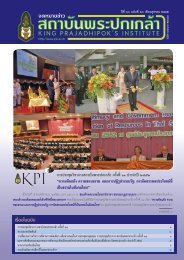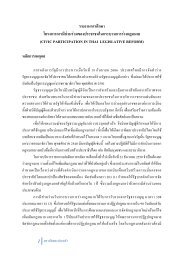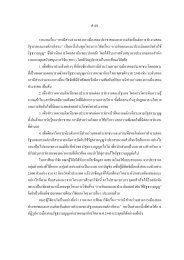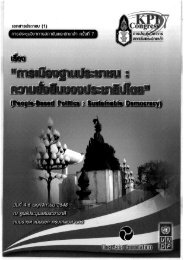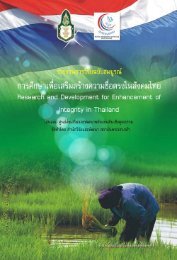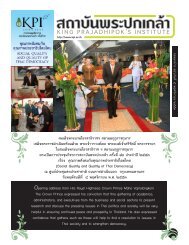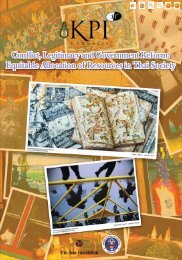SUFFiciENcy EcONOMy ANd GRASSROOtS DEvElOPMENt
SUFFiciENcy EcONOMy ANd GRASSROOtS DEvElOPMENt
SUFFiciENcy EcONOMy ANd GRASSROOtS DEvElOPMENt
Create successful ePaper yourself
Turn your PDF publications into a flip-book with our unique Google optimized e-Paper software.
292<br />
The Meaning of Sufficiency Economy <br />
International Conference<br />
It is observed that the poor members of groups under study have benefited<br />
more in terms of improvement in asset, loans for meeting emergency needs etc.<br />
Members of ‘non poor ’ category have realized benefits more in terms of<br />
improvement in asset followed by redemption of debt and other purposes.<br />
Regarding the tangible result 48.13% of the women in the study area have<br />
created income yielding asset. They are able to improve the economic conditions of<br />
the family by creating assets like goat, sheep, poultry, milch animal, coir making<br />
machines, leather stitching machines etc. The details can be had from the following<br />
table.<br />
Table – 6 Benefits to Members<br />
Sl. No. Category Poor members Others Total<br />
1. Improvement in asset 78 <br />
(35.94)<br />
115 <br />
(62.50)<br />
193 <br />
(48.13)<br />
2. Improvement in food intake 91 <br />
(41.94)<br />
- 91<br />
3. Improvement in education 13 <br />
(5.99)<br />
4. Redemption of debt 17 <br />
(7.84)<br />
5. Loans for meeting emergency needs 18 <br />
(8.29)<br />
21 <br />
(11.41)<br />
39 <br />
(21.20)<br />
9 <br />
(4.89)<br />
34 <br />
(8.48)<br />
56 <br />
(13.97)<br />
27 <br />
(6.73)<br />
Total<br />
217 <br />
(100.00)<br />
184 <br />
(100.00)<br />
401 <br />
(100.00)<br />
Source: Field Survey.<br />
Note: Figures within parenthesis indicate percentages.<br />
<br />
Perusal of Table – 6 reveals that in the case of poor members 35.94% of the<br />
members have created assets as against 62.5% in the case of ‘non – poor’ members.<br />
Apart from asset creation, the loan have also been used for education of children,<br />
redemption of old – debt and for meeting emergency needs like medical expenses,<br />
marriage expenses, social function, cloth purchase, purchase of household articles,<br />
funeral expenses, redeeming of gold jewels, payment of electricity bills, etc. It is<br />
found that while 48.13% of the total loans were utilized for production purposes and<br />
the rest 51.47% for consumption purposes. For consumption purposes that amount<br />
of loan ranged from Rs.150 to 1,200 while the production loans ranged from<br />
Rs.1,800 to 8,000/-.



